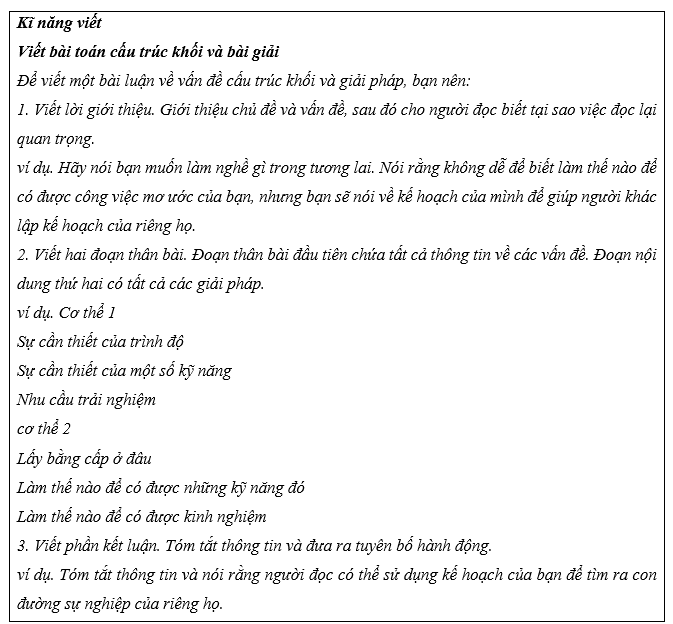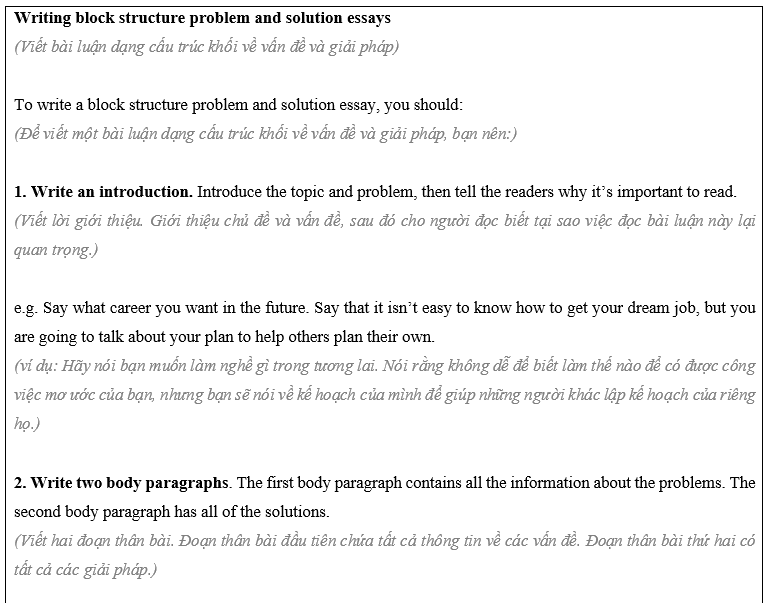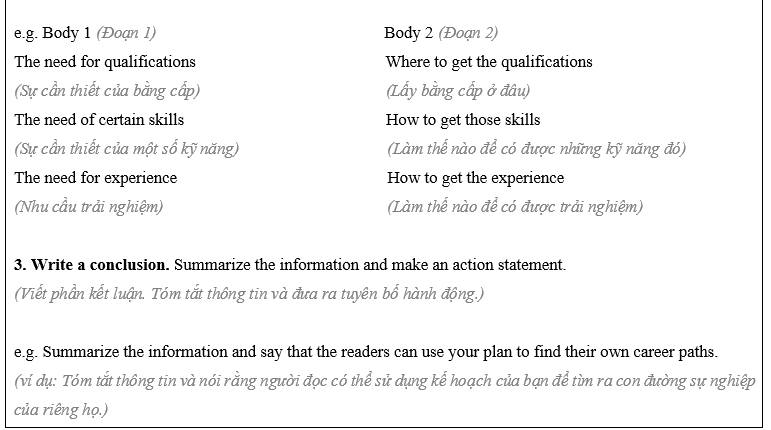4. Write an essay making predictions about the future of education (about 150-180 words). You can use ideas from Exercises 3 and 4.
(Viết một bài luận đưa ra dự đoán về tương lai của giáo dục (khoảng 150-180 từ). Bạn có thể sử dụng ý tưởng từ Bài tập 3 và 4.)
Plan
Introduction
(Paragraph 1) stating the topic, writing your general prediction
Main body
(Paragraph 2) writing positive predictions (with examples/reasons)
(Paragraph 3) writing negative predictions (with examples/reasons)
Conclusion
(Paragraph 4) restating your general prediction using different words
Dàn bài
Giới thiệu
(Đoạn 1) nêu chủ đề, viết dự đoán chung của bạn
Thân bài
(Đoạn 2) viết dự đoán tích cực (có ví dụ/lý do)
(Đoạn 3) viết dự đoán tiêu cực (có ví dụ/lý do)
Phần kết luận
(Đoạn 4) trình bày lại dự đoán chung của bạn bằng các từ khác nhau
Education is constantly changing, and we can make some predictions about what it might look like in the future. Some of these changes could be good, while others may have some challenges.
In the future, learning might become more personalized and fun. Technology like hologram devices and virtual reality headsets could be used in classrooms, making learning more interactive and exciting. Students could also use educational games and adaptive systems that adjust to their individual needs.
However, there are concerns that education could become impersonal. Instead of real teachers, students might have cyborg guides, which could make it harder to build a strong relationship with them. Additionally, if learning happens mostly online, students may miss out on making friends and having face-to-face interactions.
In summary, the future of education will likely have some positive changes, like personalized and engaging learning experiences with the help of technology. But we should be careful not to lose the personal touch of education, as having real teachers and in-person interactions are essential for a well-rounded education.
Tạm dịch
Giáo dục luôn thay đổi và chúng ta có thể đưa ra một số dự đoán về những gì nó có thể xảy ra trong tương lai. Một số thay đổi này có thể tốt, trong khi những thay đổi khác có thể gặp một số thách thức.
Trong tương lai, việc học có thể trở nên cá nhân hóa và thú vị hơn. Công nghệ như thiết bị ảnh ba chiều và tai nghe thực tế ảo có thể được sử dụng trong lớp học, giúp việc học trở nên tương tác và thú vị hơn. Học sinh cũng có thể sử dụng các trò chơi giáo dục và hệ thống thích ứng điều chỉnh theo nhu cầu cá nhân của họ.
Tuy nhiên, có những lo ngại rằng giáo dục có thể trở nên phi cá nhân. Thay vì giáo viên thực sự, học sinh có thể có người máy hướng dẫn, điều này có thể khiến việc xây dựng mối quan hệ bền chặt với họ trở nên khó khăn hơn. Ngoài ra, nếu việc học chủ yếu diễn ra trực tuyến, học sinh có thể bỏ lỡ cơ hội kết bạn và tương tác trực tiếp.
Tóm lại, tương lai của giáo dục có thể sẽ có một số thay đổi tích cực, như trải nghiệm học tập được cá nhân hóa và hấp dẫn với sự trợ giúp của công nghệ. Nhưng chúng ta nên cẩn thận để không làm mất đi tính cá nhân của giáo dục, vì có những giáo viên thực sự và tương tác trực tiếp là điều cần thiết cho một nền giáo dục toàn diện.

Các bài tập cùng chuyên đề
a. Read about writing a block structure problem and solution essay. Then, read Ben's essay again and underline the solutions.
(Đọc về viết một vấn đề cấu trúc khối và bài luận giải pháp. Sau đó, đọc lại bài luận của Ben và gạch dưới các giải pháp.)


b. Match the problems with the solutions. Use the block structure problem and solution essay model to help you.
(Nối các vấn đề với các giải pháp. Sử dụng bài toán cấu trúc khối và mô hình tiểu luận giải pháp để giúp bạn.)
A. I need a degree in social science.
B. I am not good at math.
C. I get nervous when I give a presentation.
D. I need work experience.
E.I need to have good teamworking skills.
1. I will ask my dad if his company needs some help.
2. I will take a public speaking class.
3. I will get a math tutor after school.
4. I will join the soccer team and practice with them a lot.
5. I will attend the University of Fordcester.
Now, write an essay for your school newspaper about your dream job. Talk about the three most important things you need and how you will get them. Use the Writing Skill box, the reading model, and your speaking notes to help you. Write 150-180 words.
(Bây giờ, hãy viết một bài luận cho tờ báo của trường về công việc mơ ước của bạn. Nói về ba điều quan trọng nhất mà bạn cần và cách bạn sẽ có được chúng. Sử dụng hộp Kỹ năng viết, mô hình đọc và ghi chú nói của bạn để giúp bạn. Viết 150-180 từ.)
3. Match the predictions (1-4) to the examples / reasons (a-d). Which predictions (1-4) are positive? Which are negative?
(Nối các dự đoán (1-4) với các ví dụ / lý do (a-d). Dự đoán nào (1-4) là tích cực? Dự đoán nào là tiêu cực?)
1. Learning will become simple.
2. There will be fewer human teachers who understand students' emotional needs.
3. Students will get lots of individual help.
4 Students won't socialise much in person.
a Most student clubs will be online.
b Digital classrooms will allow students to learn from anywhere.
c Robots teachers follow a computer programme and cannot react to students' behaviour.
d Cyborg guides will help students.
Your turn
4 PLANNING You are going to write an essay making predictions about education in the future. Answer the questions.
(Bạn sẽ viết một bài luận đưa ra dự đoán về giáo dục trong tương lai. Trả lời các câu hỏi.)
1 What is your general prediction?
(Dự đoán chung của bạn là gì?)
2 What positive predictions can you make?
(Bạn có thể đưa ra những dự đoán tích cực nào?)
3 What negative predictions can you make?
(Bạn có thể đưa ra những dự đoán tiêu cực nào?)
5 WRITING Write your essay (about 150-180 words).
(Viết bài luận của bạn (khoảng 150-180 từ).)
• Use the model in Exercise 1.
(Sử dụng bài mẫu trong Bài tập 1.)
• Use your answers in Exercise 4.
(Sử dụng câu trả lời của bạn trong Bài tập 4.)
• Use appropriate linking words / phrases.
(Sử dụng các từ / cụm từ liên kết phù hợp.)
• Use the plan below.
(Sử dụng kế hoạch dưới đây.)
Plan
Introduction
(Paragraph 1) stating the topic, writing your general prediction
Main body
(Paragraph 2) writing positive predictions (with examples / reasons)
(Paragraph 3) writing negative predictions (with examples / reasons)
Conclusion
(Paragraph 4) restating your general prediction using different words
Tạm dịch
Kế hoạch
Giới thiệu
(Đoạn 1) nêu chủ đề, viết dự đoán chung của bạn
Thân bài
(Đoạn 2) viết dự đoán tích cực (có ví dụ / lý do)
(Đoạn 3) viết dự đoán tiêu cực (có ví dụ / lý do)
Phần kết luận
(Đoạn 4) trình bày lại dự đoán chung của bạn bằng các từ khác nhau


Match the problems with the solutions. Use the block structure problem and solution essay model to help you.
(Nối các vấn đề với các giải pháp. Sử dụng mô hình bài luận dạng cấu trúc khối về vấn đề và giải pháp để giúp bạn.)
Many parents dream of their children becoming a doctor, engineer, or IT worker. Choose one of these jobs and write down what degree, skills, and experience you need for the job, and how to get them.
(Nhiều bậc cha mẹ mơ ước con mình trở thành bác sĩ, kỹ sư, nhân viên IT. Chọn một trong những công việc này và viết ra bằng cấp, kỹ năng và kinh nghiệm bạn cần cho công việc đó và làm thế nào để có được chúng.)

Now, use your notes to write an essay for your school’s newsletter about how to get a job as a doctor, engineer, or IT worker. Write 150-180 words.
(Bây giờ, hãy sử dụng các ghi chú của bạn để viết một bài luận cho bản tin của trường bạn về cách kiếm việc làm bác sĩ, kỹ sư hoặc nhân viên IT. Viết 150-180 từ.)
3. Use the ideas below to complete the table.
(Sử dụng những ý tưởng dưới đây để hoàn thành bảng.)
Education in the future
(Giáo dục trong tương lai)
Predictions:
• Learning will be impersonal.
• Learning will be more fun.
• Learning will be easier.
• Learning will be lonely.
Examples/Reasons:
• Lots of technology in the classroom such as hologram devices and virtual reality headsets.
• Students won't develop a good relationship with their teacher because it will be a cyborg guide and not a real person.
• Students can learn in a digital classroom rather than a physical one.
• Students who learn in a digital classroom have no in-person friendship with classmates.







